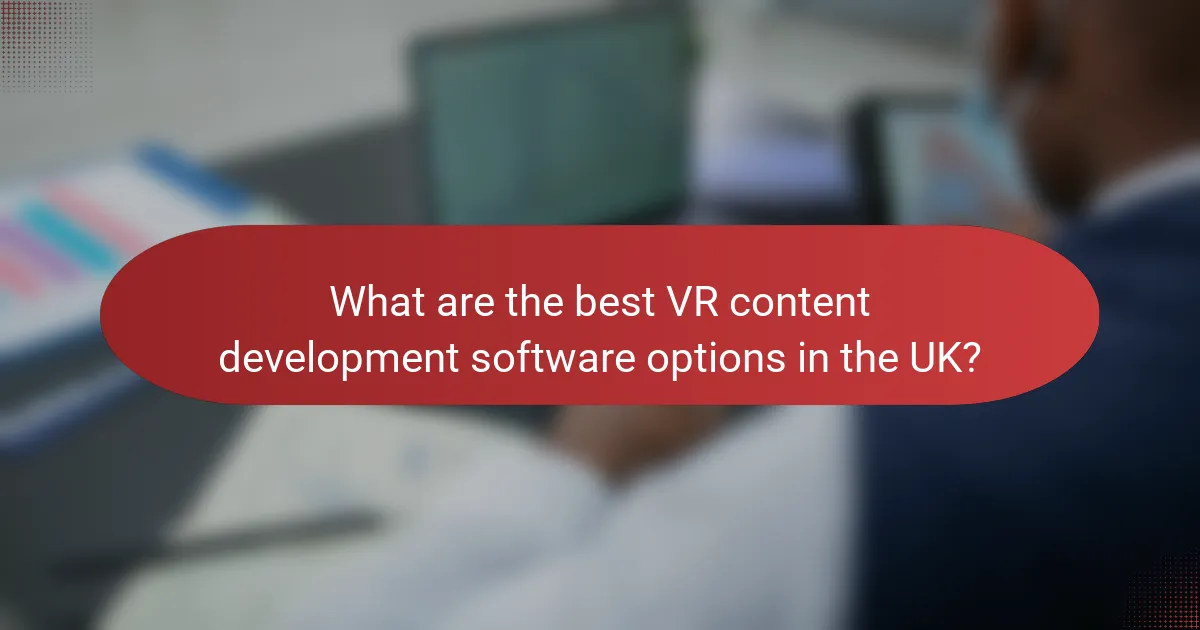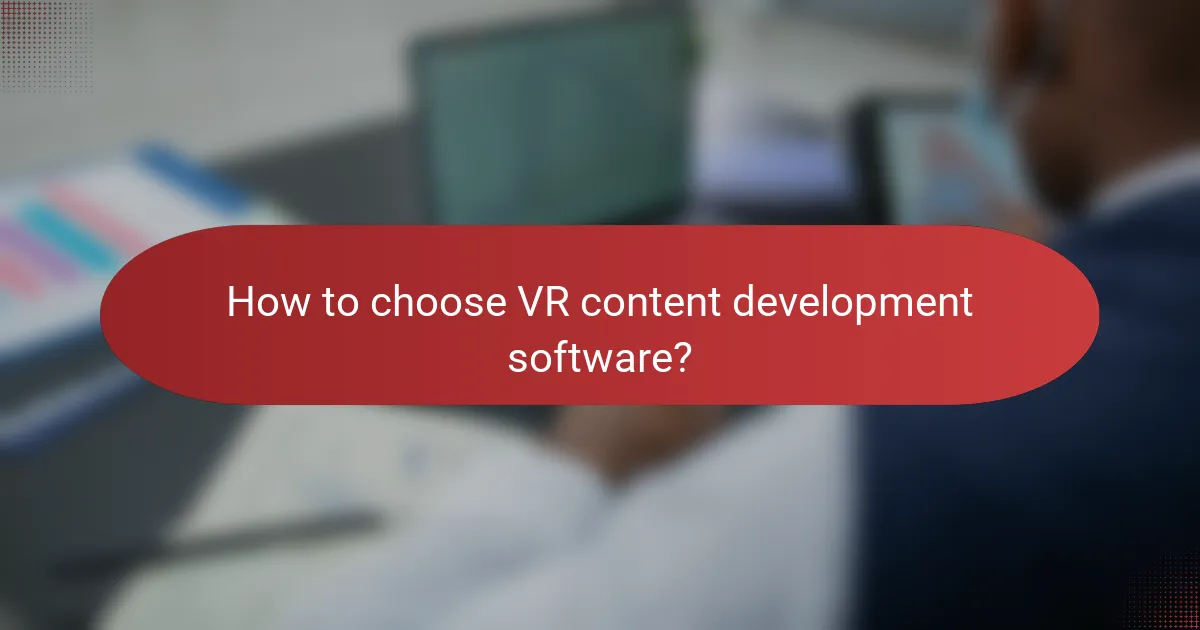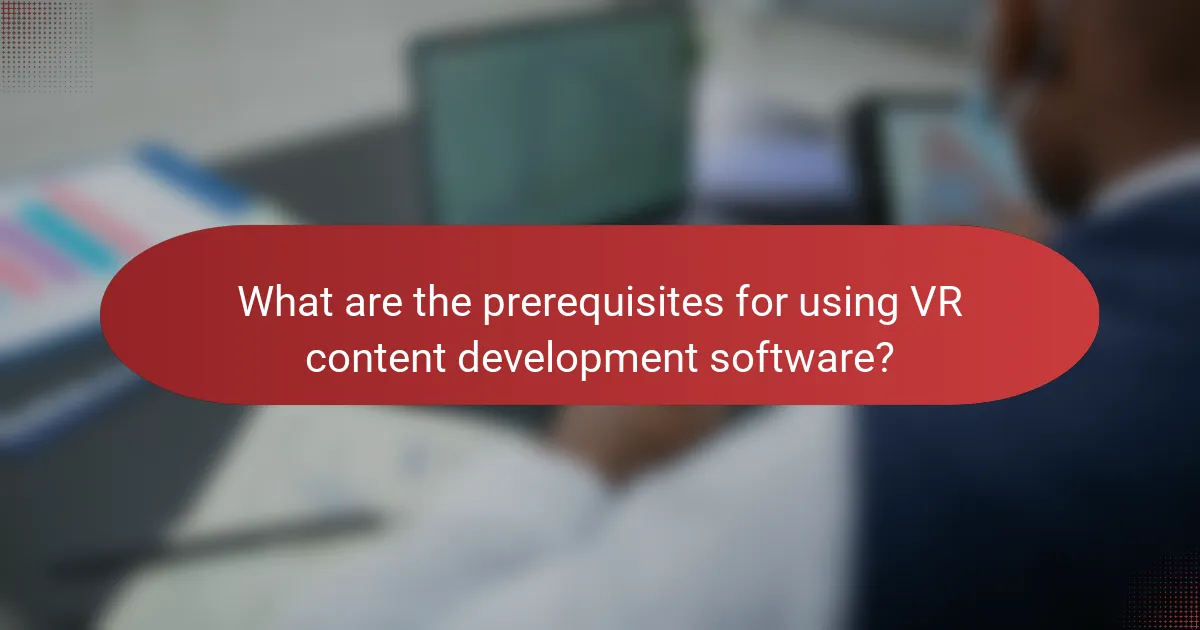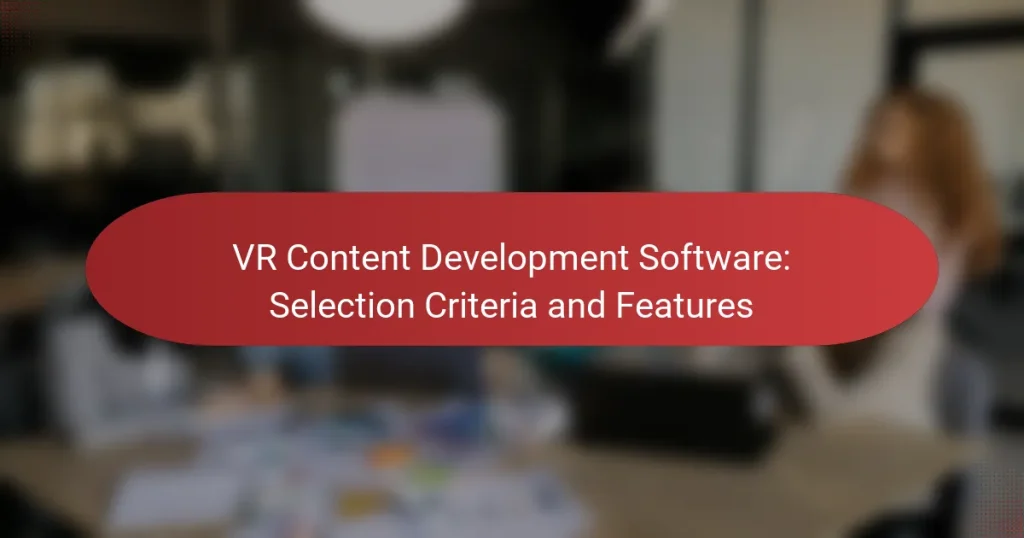When selecting VR content development software, it’s essential to consider your project’s specific needs, user experience, and budget. Popular options like Unity, Unreal Engine, and Blender offer diverse features tailored for various aspects of VR development. Key criteria include cross-platform compatibility, real-time rendering, and a user-friendly interface to ensure an efficient and immersive creation process.

What are the best VR content development software options in the UK?
The best VR content development software options in the UK include Unity, Unreal Engine, Blender, Amazon Sumerian, and Viveport. Each of these platforms offers unique features and capabilities that cater to different aspects of VR development, from game design to immersive experiences.
Unity
Unity is a leading platform for VR content development, known for its user-friendly interface and extensive asset store. It supports a wide range of VR devices, making it versatile for developers aiming to create interactive experiences.
When using Unity, consider its robust community support and the availability of numerous tutorials. This can significantly reduce the learning curve for new developers. However, be mindful of performance optimization, as poorly optimized projects can lead to lag and a subpar user experience.
Unreal Engine
Unreal Engine excels in creating high-fidelity graphics and immersive environments, making it ideal for projects that prioritize visual quality. Its Blueprint visual scripting system allows developers to create complex interactions without extensive programming knowledge.
While Unreal Engine is powerful, it may require more system resources compared to other platforms. Developers should ensure their hardware meets the recommended specifications to avoid performance issues. Additionally, take advantage of its marketplace for assets to speed up development.
Blender
Blender is an open-source 3D modeling tool that is increasingly popular among VR developers for creating assets and animations. Its powerful modeling capabilities and support for VR rendering make it a valuable addition to any VR development toolkit.
While Blender is free, it has a steep learning curve. Developers should invest time in mastering its features to fully leverage its potential. Additionally, consider integrating Blender with other software like Unity or Unreal Engine for a streamlined workflow.
Amazon Sumerian
Amazon Sumerian is a cloud-based platform that simplifies the creation of VR and AR experiences without requiring extensive programming skills. It offers a library of pre-built assets and templates, making it accessible for beginners.
One of the key advantages of Sumerian is its integration with AWS services, allowing for scalable and dynamic content. However, users should be aware of potential costs associated with AWS usage as their projects grow.
Viveport
Viveport is a VR content platform that not only allows developers to distribute their VR applications but also provides tools for creating VR experiences. It supports a variety of VR headsets, including HTC Vive and Oculus devices.
When using Viveport, developers can benefit from its subscription model, which can provide a steady revenue stream. However, it’s essential to understand the platform’s guidelines and revenue sharing policies to maximize profitability.

How to choose VR content development software?
Choosing VR content development software involves evaluating your specific project needs, user experience, and budget constraints. A clear understanding of these factors will help you select the most suitable tools for creating immersive virtual reality experiences.
Assess project requirements
Begin by defining the scope and objectives of your VR project. Consider the type of content you want to create, such as games, simulations, or educational experiences, as this will influence the software features you need.
Identify the target platforms for your VR content, whether it’s Oculus, HTC Vive, or mobile devices. Each platform may have different software compatibility and performance requirements, so ensure your chosen software aligns with your intended distribution channels.
Evaluate user experience
User experience is crucial in VR development. Look for software that offers intuitive interfaces and robust support for user interaction, such as gesture recognition and haptic feedback. This will enhance the overall immersion and engagement of your VR content.
Consider testing the software with a small group of users to gather feedback on usability and functionality. This can help you identify potential issues early and ensure that the final product meets user expectations.
Consider budget constraints
Your budget will significantly impact your choice of VR content development software. Prices can vary widely, from free open-source options to premium software that may require substantial investment. Assess the long-term value of the software against its cost.
Factor in additional costs such as hardware requirements, training, and ongoing support. It’s often beneficial to choose software that offers a good balance between features and affordability, ensuring you get the most out of your investment without overspending.

What features should VR content development software have?
VR content development software should have features that enhance usability, performance, and accessibility across various platforms. Key aspects include cross-platform compatibility, real-time rendering capabilities, a user-friendly interface, and access to a comprehensive asset library.
Cross-platform compatibility
Cross-platform compatibility ensures that VR content can be used on multiple devices and operating systems, such as Oculus, HTC Vive, and PlayStation VR. This feature broadens the audience reach and enhances user experience by allowing developers to create content that works seamlessly across different hardware.
When selecting software, check for support of major platforms and consider tools that facilitate easy porting of projects. This can save time and resources, allowing developers to focus on content creation rather than troubleshooting compatibility issues.
Real-time rendering
Real-time rendering is crucial for creating immersive VR experiences, as it allows for immediate visual feedback and interaction. This feature enhances the realism of the VR environment, making it more engaging for users.
Look for software that supports high-quality graphics and low latency rendering, ideally in the low tens of milliseconds. This ensures smooth performance, which is essential for maintaining user immersion and preventing motion sickness.
User-friendly interface
A user-friendly interface simplifies the development process, making it accessible for both beginners and experienced developers. Intuitive navigation, clear tool layouts, and helpful tutorials can significantly reduce the learning curve.
Choose software that offers customizable workflows and drag-and-drop functionalities. This can streamline the development process and allow for quicker iterations, ultimately leading to a more efficient production cycle.
Asset library access
Access to a robust asset library is vital for speeding up the development process. A comprehensive library provides pre-made models, textures, sounds, and animations that can be easily integrated into projects, saving time and effort.
Evaluate the quality and variety of assets available in the library. Some software may offer assets tailored to specific industries or themes, which can be beneficial depending on the project’s focus. Additionally, consider whether the library includes assets that are royalty-free or require licensing fees.

What are the pricing models for VR content development software?
VR content development software typically offers several pricing models, including subscription-based, one-time purchase, and freemium options. Each model has its own advantages and considerations, making it essential to choose one that aligns with your project needs and budget.
Subscription-based
Subscription-based pricing involves paying a recurring fee, often monthly or annually, to access the software. This model is beneficial for users who prefer lower upfront costs and want to stay updated with the latest features and improvements.
Many subscription plans also include customer support and cloud storage, which can enhance the development experience. However, over time, the total cost can exceed that of a one-time purchase, especially for long-term projects.
One-time purchase
A one-time purchase model requires a single upfront payment for lifetime access to the software. This can be appealing for users who want to avoid ongoing fees and prefer to own the software outright.
While this model may seem cost-effective initially, it often lacks updates and support unless additional fees are paid. Users should consider whether they will need ongoing access to new features or support when choosing this option.
Freemium options
Freemium options allow users to access basic features of the software for free, with the option to upgrade to a paid version for advanced functionalities. This model is ideal for those who want to test the software before committing financially.
However, users should be aware that free versions may have limitations, such as watermarks or restricted export options. Evaluating whether the free features meet your needs is crucial before deciding to upgrade.

What are the prerequisites for using VR content development software?
To effectively use VR content development software, users need to meet specific hardware, software, and skill level requirements. These prerequisites ensure that the development process is smooth and that the resulting content performs well across various VR platforms.
Hardware specifications
VR content development requires robust hardware to handle the intensive processing demands. A powerful computer with a multi-core processor, at least 16 GB of RAM, and a high-end graphics card (such as NVIDIA GeForce RTX series) is essential for creating immersive experiences.
Additionally, VR headsets like the Oculus Rift, HTC Vive, or Valve Index should be compatible with the development software. Ensure that your hardware meets the recommended specifications of the VR platform you intend to target.
Software installation
Installing VR content development software typically involves downloading the application from the developer’s website or a digital distribution platform. Ensure your operating system is compatible, as many VR tools require Windows or macOS.
After installation, you may need to configure settings to optimize performance, including graphics settings and VR headset calibration. Familiarize yourself with any additional plugins or SDKs required for specific VR platforms to enhance functionality.
Skill level requirements
Developing VR content generally requires a moderate to advanced skill level in programming and 3D design. Familiarity with languages such as C# or C++ and experience with game engines like Unity or Unreal Engine are often necessary.
For beginners, many online courses and tutorials are available to build foundational skills. However, expect a learning curve, especially when integrating complex interactions and optimizing for performance in a VR environment.


